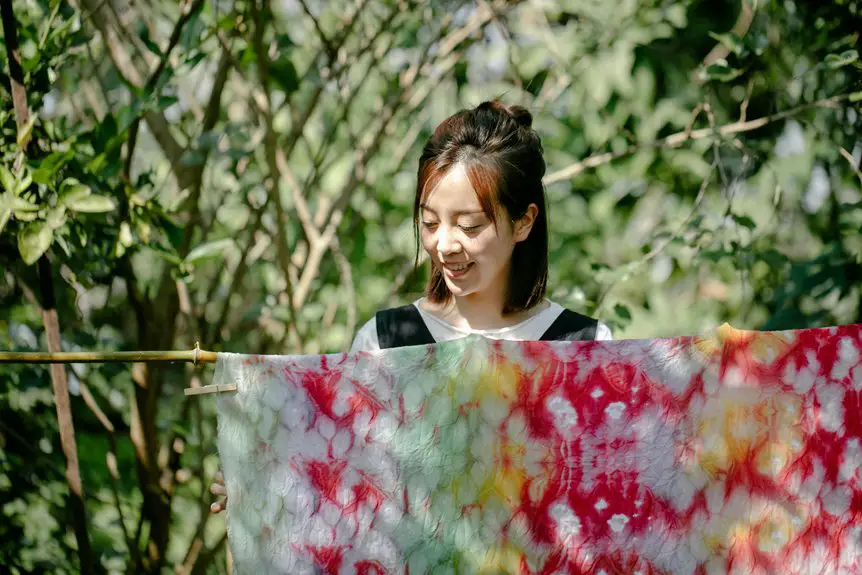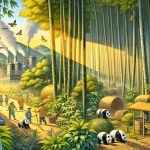When you hear about bamboo fabric, it sounds like the perfect eco-friendly choice, right? Its rapid growth and natural biodegradability make it seem like a miracle solution. But before you fully commit, consider the hidden costs of its production. Are those sustainability claims as robust as they appear? You might be surprised by what lies beneath the surface. Let’s uncover the truth behind this trendy material.
Table of Contents
Key Takeaways
- Bamboo grows rapidly and regenerates quickly, making it a sustainable resource when managed properly.
- Production methods often involve harmful chemicals, leading to pollution and health risks for workers and communities.
- While bamboo fabric decomposes faster than synthetic materials, chemical treatments can hinder its biodegradability.
- Marketing claims of bamboo fabric being eco-friendly can be misleading, requiring consumers to scrutinize sourcing and production practices.
- Certifications like OEKO-TEX and GOTS can help identify truly sustainable bamboo products amidst greenwashing claims.
The Rapid Growth and Sustainability of Bamboo
Although bamboo grows rapidly and requires minimal resources, many people still underestimate its sustainability. This remarkable plant can reach heights of up to 35 inches in just a day, making it one of the fastest-growing plants on Earth.
Its extensive root system not only stabilizes soil but also helps prevent erosion, contributing positively to the environment. Bamboo thrives without the need for pesticides or fertilizers, making it an eco-friendly choice.
When harvested, it regenerates quickly, ensuring a continual supply without depleting natural resources. By choosing bamboo for fabrics, you’re supporting a renewable resource that minimizes environmental impact.
Embracing bamboo means embracing a sustainable future, allowing you to reduce your carbon footprint while enjoying the benefits of this versatile material.
Environmental Costs of Bamboo Fabric Production
While bamboo’s rapid growth and low resource needs paint a picture of sustainability, the production of bamboo fabric can come with significant environmental costs. The process often involves harsh chemicals, especially during the conversion of bamboo into rayon, which can pollute local water sources.
You might also find that large-scale bamboo farming can lead to habitat destruction, as forests are cleared to make way for monoculture plantations. This not only affects biodiversity but can also disrupt local ecosystems.
Additionally, the transportation of bamboo fabric adds to its carbon footprint, diminishing its eco-friendly appeal. So, while bamboo seems like a sustainable choice, it’s essential to take into account these hidden environmental impacts before making a purchase.
Biodegradability: Bamboo vs. Traditional Fabrics
When you consider biodegradability, bamboo fabric often claims a natural edge over traditional materials.
However, the chemical processes used in creating bamboo textiles can greatly impact their decomposition rates.
Let’s compare the origins of these fibers to see how they truly stack up regarding environmental sustainability.
Natural Decomposition Rates
As you explore the biodegradability of fabrics, you’ll find that bamboo has some distinct advantages over traditional materials like cotton or polyester. Bamboo fibers break down more rapidly in composting conditions, typically decomposing within a few months. In contrast, synthetic fabrics like polyester can take hundreds of years to decompose, contributing notably to landfill waste.
Here’s a quick comparison:
| Fabric Type | Decomposition Time |
|---|---|
| Bamboo | 3-6 months |
| Cotton | 5-6 months |
| Wool | 1-5 years |
| Polyester | 200+ years |
Choosing bamboo not only supports sustainable practices but also helps reduce your environmental footprint. It’s an eco-friendly choice in a world needing change.
Chemical Processing Impact
Bamboo’s natural decomposition rates are impressive, but they can be considerably affected by the chemical processing involved in turning the plant into fabric.
Many bamboo fabrics undergo extensive chemical treatment, which can include toxic substances that hinder biodegradability. While bamboo itself decomposes quickly, the added chemicals can linger in the environment, reducing overall sustainability.
In contrast, traditional fabrics like cotton and polyester also face similar issues. Cotton often requires pesticides, while polyester is derived from petroleum, making it less biodegradable.
If you’re considering bamboo fabric for its eco-friendliness, it’s essential to research the production process. Look for brands that prioritize sustainable practices and minimize harmful chemicals, ensuring your choice aligns with your environmental values.
Comparing Fiber Origins
While bamboo is often hailed for its eco-friendly properties, it’s essential to compare its biodegradability with that of traditional fabrics like cotton and polyester.
Bamboo fabric can break down more quickly in composting environments, returning nutrients to the soil. In contrast, cotton is also biodegradable, but its decomposition can be slower, depending on the chemicals used in its processing.
Polyester, on the other hand, is a synthetic material that can take hundreds of years to decompose, contributing greatly to landfill waste. When you choose bamboo over polyester, you’re making a more sustainable choice.
However, keep in mind that the eco-friendliness of bamboo largely depends on the processing methods used, which can vary widely across different brands.
The Illusion of Eco-Friendliness in Marketing
Many brands tout bamboo fabric as a sustainable choice, but you might find that their marketing often obscures the truth.
Bamboo fabric is often marketed as sustainable, yet the reality may be more complicated than it seems.
What seems eco-friendly on the surface can hide some less savory realities. Here’s what to reflect on:
- Sourcing Transparency: Are brands clear about where their bamboo is sourced?
- Chemical Processing: Most bamboo fabrics undergo heavy chemical treatment, which can diminish eco-claims.
- Life Cycle Impact: Reflect on the entire lifecycle of the product, not just its raw materials.
- Misleading Labels: Terms like “natural” and “organic” can be misleading without proper certifications.
- Consumer Awareness: Many consumers remain unaware of the complexities behind bamboo fabric production.
You deserve to know what’s really behind those green labels.
Health Risks for Workers and Consumers
When you think about bamboo fabric, consider the health risks that might affect both workers and consumers.
Chemical exposure during production can lead to serious long-term health effects, not just for those making the fabric but also for the communities surrounding the factories.
It’s vital to understand how these risks impact everyone involved in the bamboo fabric lifecycle.
Chemical Exposure Risks
Although bamboo is often celebrated for its eco-friendly properties, the production process can expose both workers and consumers to harmful chemicals.
During the conversion of bamboo into fabric, toxic substances like sodium hydroxide and carbon disulfide are frequently used. These chemicals pose serious health risks, raising concerns about safety in the workplace and at home.
Consider these potential risks:
- Skin irritation and allergic reactions for consumers
- Respiratory issues for workers exposed to fumes
- Long-term exposure leading to chronic health problems
- Contaminated water sources affecting local communities
- Lack of regulation and transparency in production practices
Being aware of these risks can help you make more informed choices about bamboo products.
Long-term Health Effects
While the immediate effects of chemical exposure in bamboo fabric production are concerning, the long-term health risks for both workers and consumers can be even more alarming.
Prolonged exposure to harmful chemicals used in the processing of bamboo can lead to serious health issues, including respiratory problems, skin irritations, and even chronic illnesses. For workers, inadequate safety measures might result in cumulative exposure, increasing their risk of developing long-term conditions.
Consumers may not be immune either; continuous use of bamboo fabrics treated with harsh chemicals could lead to skin sensitivities or allergic reactions over time.
It’s crucial to be aware of these potential health implications when choosing bamboo products, as the promise of sustainability doesn’t always guarantee safety for everyone involved.
Community Health Impact
The health risks associated with bamboo fabric production extend beyond individual workers and consumers, impacting entire communities. When you consider the production processes, several concerns arise that affect everyone involved.
- Chemical exposure from toxic solvents used in processing
- Air quality deterioration due to emissions from manufacturing plants
- Water contamination from runoff affecting local drinking supplies
- Poor working conditions leading to physical and mental health issues
- Economic instability as communities depend on a potentially harmful industry
These factors can create a ripple effect, harming not only those directly involved in bamboo fabric production but also the broader community.
It’s crucial to weigh these health risks against the perceived eco-friendliness of bamboo fabric, as the reality may not align with the marketing claims.
Comparing Bamboo Fabric With Cotton and Synthetics
When you compare bamboo fabric with cotton and synthetic materials, you’ll quickly notice distinct differences in sustainability, comfort, and environmental impact.
Bamboo fabric is often touted for its rapid growth and minimal pesticide use, making it a greener choice compared to conventional cotton, which requires significant water and chemicals.
Bamboo fabric’s fast growth and low pesticide use make it a more sustainable option than traditional cotton.
With regard to comfort, bamboo is soft, breathable, and moisture-wicking, providing a luxurious feel against your skin.
Synthetic fabrics, while durable and often cheaper, lack breathability and can trap heat, leading to discomfort. Additionally, their production typically involves harmful chemicals and non-biodegradable materials, posing environmental risks.
The Role of Certifications and Transparency
As you explore the world of bamboo fabric, understanding the role of certifications and transparency becomes essential in determining its true sustainability.
Certifications can guide you in identifying genuinely eco-friendly products and help you avoid misleading claims. Transparency from brands fosters trust and allows you to make informed decisions.
- Look for certifications like OEKO-TEX, GOTS, or FSC.
- Research the manufacturing process and sourcing of materials.
- Check if brands share information about their environmental impact.
- Seek out third-party reviews and testimonials.
- Investigate if the company participates in sustainability initiatives.
Misleading Claims and Greenwashing Tactics
While bamboo fabric is often marketed as an eco-friendly alternative, many brands employ misleading claims and greenwashing tactics that can confuse consumers. You might encounter terms like “sustainable” or “organic,” but without proper certifications, these words can be empty. Brands might promote bamboo’s rapid growth, yet ignore the harmful chemicals used in processing.
Here’s a breakdown of common claims versus reality:
| Claim | Reality | Impact on Consumer |
|---|---|---|
| “100% Natural” | Often chemically processed | Misleading perception |
| “Biodegradable” | Takes years to decompose | False sense of disposal |
| “Eco-Friendly” | Depends on production methods | Uninformed purchasing |
| “Sustainable” | May not consider local ecosystems | Environmental harm |
| “Organic” | Rarely certified | Health risks ignored |
Community Impact and Public Health Concerns
Misleading claims about bamboo fabric extend beyond marketing tactics; they also have real consequences for communities and public health. When companies exaggerate bamboo’s benefits, they often overlook the environmental and health implications tied to its production.
Here’s what you should consider:
- Pesticide Use: Some bamboo farming practices rely on harmful chemicals that can contaminate local water supplies.
- Worker Exploitation: The push for cheaper bamboo products may lead to poor working conditions and unfair wages.
- Deforestation Risks: Unsustainable harvesting can lead to habitat loss for local wildlife.
- Community Displacement: Large-scale bamboo plantations may displace indigenous communities and disrupt their livelihoods.
- Health Risks: Chemical treatments in processing can release toxins, posing health risks to workers and consumers alike.
Awareness of these issues is vital as you navigate bamboo fabric choices.
The Future of Bamboo in Sustainable Fashion
The future of bamboo in sustainable fashion hinges on a commitment to ethical practices and innovation. You’ll see brands increasingly prioritize transparency in their supply chains, ensuring that bamboo is sourced responsibly.
The future of bamboo in sustainable fashion relies on ethical practices and transparent supply chains.
As consumer demand for eco-friendly materials grows, expect advancements in production processes that minimize environmental impact. Companies are exploring ways to enhance bamboo’s durability and versatility, making it a more appealing option for various garments.
You’ll likely witness collaborations between fashion designers and sustainability experts, driving creativity while adhering to eco-friendly principles.
As awareness about greenwashing spreads, staying informed will be essential. By supporting brands that genuinely commit to sustainable bamboo practices, you can help shape a future where fashion and environmental responsibility coexist harmoniously.
Frequently Asked Questions
What Are the Best Uses for Bamboo Fabric in Fashion?
Bamboo fabric’s soft texture and breathability make it perfect for activewear, loungewear, and eco-friendly clothing lines. You’ll love its moisture-wicking properties and natural antibacterial qualities, enhancing comfort while keeping you stylish and sustainable.
How Does Bamboo Fabric Feel Compared to Cotton?
When you touch bamboo fabric, you’ll notice it’s incredibly soft, often smoother than cotton. It has a silky feel, and its moisture-wicking properties keep you comfortable, making it a great choice for various clothing items.
Is Bamboo Fabric Suitable for Sensitive Skin?
Bamboo fabric is generally suitable for sensitive skin because it’s soft, breathable, and hypoallergenic. If you’ve experienced irritation from other materials, you might find bamboo to be a gentle alternative that feels comfortable against your skin.
Can Bamboo Fabric Be Recycled?
You might think bamboo fabric’s a recycling superhero, but it’s not quite that simple. While some facilities can recycle it, most processes require special conditions. Always check local guidelines before tossing it in the recycling bin!
What Are Alternatives to Bamboo Fabric?
If you’re looking for alternatives to bamboo fabric, consider organic cotton, hemp, or linen. These materials offer sustainable options with minimal environmental impact, providing comfort and durability without compromising your eco-friendly lifestyle. Explore your choices!
- Tetron Fabric for Marine Applications: Durability and Use Cases - June 18, 2025
- Tetron Fabric for Outdoor Furniture: Weather Resistance and Care - June 18, 2025
- Tetron Fabric for Wall Coverings: Style and Application Tips - June 18, 2025






